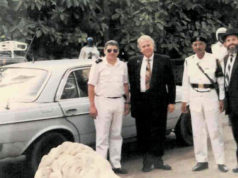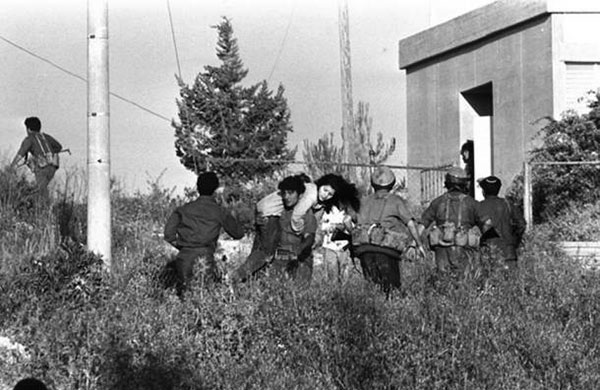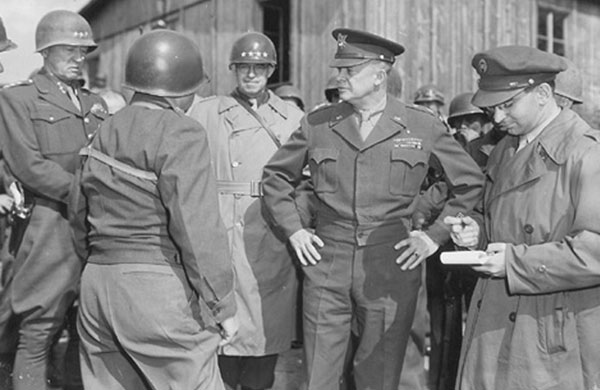When a Jew turns 65, he/she must move to Florida—it’s the law. (It’s not really the law.) There are approximately 750,000 Jews living in Florida today. In fact, it has the third largest Jewish population in the country, and the numbers continue to rise. However, Jews have not always lived in Florida—there was a time when they were not welcome.

Florida was discovered by Ponce de Leon in 1513. It was under Spanish rule until it became a US Territory in 1821 and then the nation’s 27th state in 1845. At first, Jews were not welcome in Florida. Then in 1763 in the Treaty of Paris, following the French and Indian War, Florida was given to the British and Louisiana was given to the Spanish. Three Sephardic Jews who had been living in New Orleans, Samuel Israel, Joseph de Palacios and Alexander Solomons, moved to Pensacola. More Jews moved to North Florida during the next few decades, but the Jewish population remained small during this time, numbering no more than a dozen individuals.
When Florida became a state on March 3, 1845, there were still fewer than 100 Jews living there. Jewish pioneers Philip Dzialynski, Robert Williams and Morris Endel each brought a Torah with them when they settled in Jacksonville (1850), Tallahassee (1865) and Gainesville (1865), respectively. This insured that Jewish worship would take place on the Florida frontier. In 1876, Beth El, in Pensacola, became Florida’s first congregation.

Today, South Florida hosts the largest concentration of Jews outside of Israel. The first South Florida community to welcome Jews was West Palm Beach. Jews first settled there in 1893 when Henry Flagler brought his railroad there. Among the founders was Joseph Mandel, who served as mayor of West Palm Beach from 1923 to 1924. Another founder was Max Serkin, a produce farmer who had arrived in 1896; his daughter is thought to be the first Jewish child born in Palm Beach County.
Moses Elias Levy, a Sephardic Jew, believed that Florida could be a new Zion—a home for the persecuted Jews of Europe. He came from one of the many Jewish families that had been expelled from the Iberian Peninsula toward the end of the fifteenth century and had found refuge in northern Africa. He was raised in Gibraltar, made his way to St. Thomas in 1800 and engaged in the lumber business, accumulating a considerable fortune. He relocated to Cuba in 1816, furnishing supplies to the army. In 1819, he went to Florida for business, and predicted that soon the United States would take it over from Spain. By 1820 he began purchasing land in north central Florida that eventually totaled 100,000 acres. He envisioned a haven for Jews escaping persecution. On 1,000 acres in Micanopy (near Gainesville) he built Pilgrimage Plantation, where Jews could study Hebrew. He hired Frederick Warburg, who was probably a member of the German Jewish banking family, to help recruit Jewish settlers for his colony. It is documented that Warburg and at least five other German Jewish families lived on the plantation, as did Levy’s son David, who eventually became the first Jew to serve in the US Senate.

In 1832, the first Jews arrived in Key West. The Key West Jewish community was instrumental in the cigar industry. Many Jews and Cubans became close business partners and friends, which led to Jewish support for Cuban independence throughout the 1890s. Many of the Jewish settlers were merchants. When Key West passed a heavy tax for pushcarts, the Jews of Key West opened their own stores and permanently settled in the area. In 1907, leaders of the community opened Bnai Zion.
By the turn of the 20th century, there were six Jewish congregations in Florida. All remain in existence today, although some of the names have changed. After the railroads opened up South Florida in the 1890s, Jews began to settle there. The Jewish migration trickle of the 18th and 19th centuries turned into a huge gusher after World War II, especially in Dade County. In the 1890s the Florida Jewish population was about 2,500; by the 1950s it was 70,000 and today it is nearly 750,000 and growing.

Until the railroad arrived in Florida, it was difficult to get to Miami. The earliest permanent Jewish settler in Miami was Isidor Cohen who helped found many Jewish and civic organizations.
The early Jews of Miami (about 25 people) had religious services in homes beginning in 1896. After the great fire that destroyed most of the businesses and a yellow fever epidemic in 1899, the Jewish population declined to three people.
During the early 1900s Miami Beach did not welcome Jews. Developer Carl Fisher placed restrictions in his land deeds, prohibiting the sale of lots north of Fifth Street to Jews. Eventually, several modest Jewish-owned hotels and apartments arose on property sold to Jews by the Lummus Brothers south of Fifth Street.
The Nemo Hotel, on Collins Avenue and First Street, was built in 1921 by Sam Magid and Joseph and Harry Goodkowsky, who had operated successful kosher hotels in New England. The Nemo catered to kosher winter tourists. Rose and Jeremiah Weiss and their children, Milton, Malvina and Eugene, who moved to Miami Beach in 1919, lived on the same block. Rose Weiss, a deeply compassionate and caring woman and one of the community’s most popular residents, was known as “the Mother of Miami Beach.” A civic activist, Rose Weiss attended every city commission meeting for nearly 40 years.
A fantastic real estate boom in the mid 1920s lured many young Jews, such as Leonard Abess, Max Orovitz and Baron de Hirsch Meyer, to the area. Especially active was Henri Levy, a French-born Jew who arrived in 1922 with his family. He called Miami Beach “a lush tropical paradise,” and subsequently developed the communities of Normandy Isle and Normandy Beach North, which later became Surfside. By the end of the decade, Greater Miami replaced Jacksonville as the center of Florida Jewry, despite the fact that many hotels continued to exhibit signs that read “Gentile Only.”
The 1930s marked the dismantling of restrictive barriers to Jewish ownership of real estate throughout Miami Beach, as large numbers of Jews purchased commercial properties from debt-ridden owners, only too happy to sell them. Jews also began buying residential lots whose restrictive covenants proved impossible to enforce after the property had changed owners a couple of times. While discrimination had by no means vanished, Jews continued to migrate to the sunny shores of Miami Beach.
It soon became known for its casinos and night life. Irwin Levy, Robert Rapaport and Aaron Schecter developed Century Villages beginning in 1967 that drew a large number of retired garment workers and teachers to the area. Several years later, other retirement and golf communities were developed in Delray Beach and the “rush” of Jewish settlement accelerated.
The Sephardic Congregation of Florida, originally knows as Cuban Sephardic Hebrew Congregation, was founded in 1968 by Cuban Jewish refugees forced into exile during the early 60s.
Broward County hosts Florida’s second largest Jewish population. The first known Jewish settler there was Louis Brown who arrived in 1910 and two years later opened a department store. David Sokolow’s sister married Brown in 1915 and David and Louis teamed up to open more stores in Hollywood and Pompano.
By 1940 there were 1,000 Jews in Broward County and the dozen or so Jewish families in Hollywood began to have religious services. During World War II the airfields were converted into training facilities. After the War, thousands of servicemen recalled the nice life in Broward and returned with their families; thousands more soon joined them. By 1970, there were 40,000 Jews in Broward. Today there are more than 50 congregations.
Over the years, Jews moved to Florida for many reasons: to escape persecution, for economic opportunity, to join family members already there, for the climate and lifestyle, for their health and to retire. The largest number of Jews settled in Florida after World War II, including Holocaust survivors.
Jews have been intensely involved in development, especially Shepard Broad, who created Bay Harbor Islands in 1947 and built the Broad Causeway to connect it to North Miami. Arnold Rosen began building houses in 1946 on $50 lots; 10 years later he partnered with Leonard Miller to form Lennar Corporation, which is one of the nation’s largest homebuilders today.
For more information about Florida’s Jewish history, visit the Florida Jewish Museum in Miami Beach.



